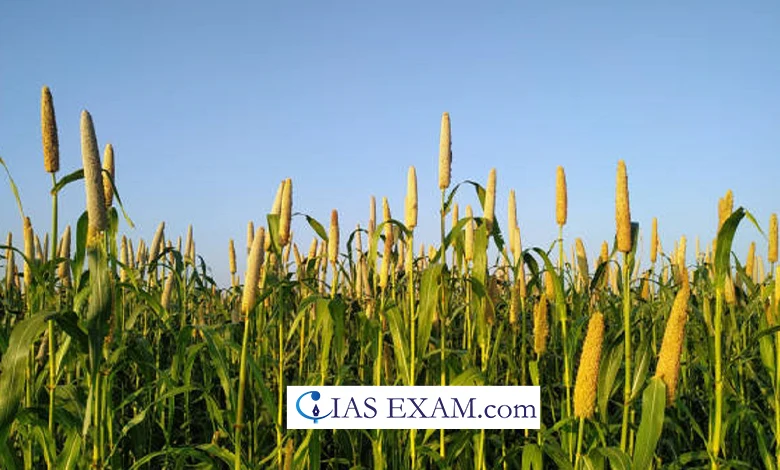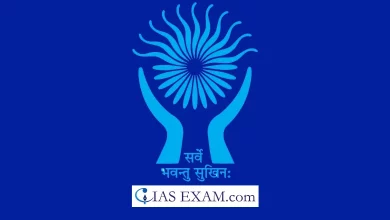Daily Current Affairs for UPSC
Growth registered in Agriculture and Allied Sectors
Syllabus- Economy [GS Paper-3]

Context
As per the NITI Aayog, the agriculture and allied sectors may register more than 6% growth in 2024-25.
About
- The year 2024-25 may be distinctly favorable for agriculture, particularly because of two factors.
- One, the monsoon rainfall can be regular or above normal, as per the reports by several businesses. Even in terms of regional distribution, the forecasts are encouraging.
- Two, the agriculture growth in 2023-24 was 0.67%, because of this the bottom for 2024-25 is low.
Agriculture Sector in India
- India is one of the principal players in the agriculture area worldwide and it is the number one supply of livelihood for ~55% of India’s population.
- It is the second-biggest producer of fruit, veggies, tea, farmed fish, sugarcane, wheat, rice, cotton, and sugar.
- India occupies fifth place globally with a total area of 2.66 million hectares in natural farming.
Recent Trends
- The percentage of agriculture in general Gross Value Added (GVA) of the financial system has declined from 35% in 1990-91 to 15% in 2022-23, specially due to rapid expansion in the industrial and service sector GVA.
- In growth phrases, the agriculture and allied sector has registered an average annual growth of 4% during the last 5 years.
- Fall in the Agricultural Prices: The stagnation or fall of agricultural prices within the market was not ameliorated by equivalent rise in minimum support prices (MSP).
- For major foodgrain crops, the MSPs rose by an average 5% per annum between 2013-14 and 2023-24.
- Real Income of Farmers: The real earning of agricultural families from cultivation fell by about 1.4% between 2012-13 and 2018-19.
- The fall of incomes from cultivation was not only due to the stagnation or fall of agricultural expenses, but also due to a sharp increase in the expenses of inputs in agriculture, mainly fertilizers.
- Public Investment: The public investment in agriculture, in general as well as in particular fields like agricultural studies and extension, had been stubbornly stagnant, and now and again even fell, during the last decade.
- Consequently, capital funding in agricultural and allied sectors did not rise.
- Rising costs: The actual expenses of agriculture were rising for several years. The wholesale price index (WPI) of agri-commodities is rising quicker than non-agri-commodities.
Major Challenges Faced by the Agricultural Sector
- Water shortage & irrigation: India’s agriculture is closely dependent on monsoon rain, making it prone to droughts and inconsistent rainfall patterns.
- Access to irrigation centers and water management are major challenges, especially in areas with limited water resources.
- Lack of access to credit & finance: Small and marginal farmers often face difficulties in gaining access to credit and financial services.
- Limited availability of low priced credit restricts their potential to spend money on current farming equipment and fine seeds and fertilizers, hampering their productivity.
- Small landholdings: Average farmers are small landholders, main to fragmented and uneconomical farming practices.
- This makes it tough for them to adopt the latest agricultural strategies and technologies, resulting in lower productivity.
- Outdated farming practices: A considerable portion of Indian farmers rely on traditional and old farming techniques.
- Limited access to records, lack of knowledge about contemporary strategies and resistance to change hinder the adoption of advanced farming practices.
- Market volatility & price fluctuations: Farmers in India regularly face market volatility because of loss of effective market linkages, intermediaries and price information.
Developmental programmes applied by the government
- Pradhan Mantri Kisan Samman Nidhi (PM-KISAN): It is an profits aid scheme imparting Rs. 6000 per year in three equal installments.
- Pradhan Mantri Krishi Sinchai Yojana (PMKSY): This scheme specializes in improving water use efficiency in agriculture.
- It consists of additives consisting of micro-irrigation, watershed development, and the promotion of efficient water management practices.
- Pradhan Mantri Fasal BimaYojana (PMFBY): It was launched in 2016 addressing troubles of high top rate costs for farmers and discount in sum insured due to capping.
- Per Drop More Crop: The scheme aims to boom water use efficiency, lowering cost of inputs and increasing productivity at the farm level through Micro Irrigation technology.
- PM-AASHA (Pradhan Mantri Annadata Aay Sanrakshan Abhiyan): This scheme aims to make certain that farmers get remunerative prices for their produce.
- It accommodates Price Support Scheme (PSS), Price Deficiency Payment Scheme (PDPS), and Pilot of Private Procurement & Stockist Scheme (PPPS).
- Namo Drone Didi: The scheme aims to offer drones to 15000 decided on Women SHGs for providing rental services to farmers for agriculture purposes (application of fertilizers and pesticides).
- Kisan Credit Card (KCC) Scheme: The KCC scheme provides farmers with credit at sponsored interest prices, facilitating timely access to credit for agricultural and allied activities.
- National Agriculture Market (e-NAM): The e-NAM is an internet platform that aims to create a unified countrywide marketplace for agricultural commodities.
- It enables farmers to sell their produce to shoppers everywhere in the country, promoting transparency and fair pricing.
Way Ahead
- Substantial growth in farmers income and transformation of agriculture require a paradigm shift in the whole approach towards the agriculture sector.
- Advancement in technological knowledge led generation, more advantageous function of private sector in both pre and post harvest phases, liberalized output market, lively land hire marketplace, and emphasis on performance will equip agriculture to address challenges.
- A well co-ordinated action and method between the Centre and the states is needed to ensure that agriculture marches to the following level of development along with other sectors.
Source: The Hindu
UPSC Mains Practice Question
Q.Despite having several measures to reduce the vulnerability of farmers in India, the agriculture sector and farmers continue to suffer losses. Suggest some measures that can be taken to improve their conditions. (250 words)





.png)



